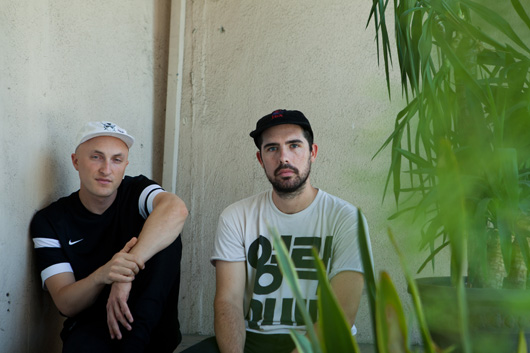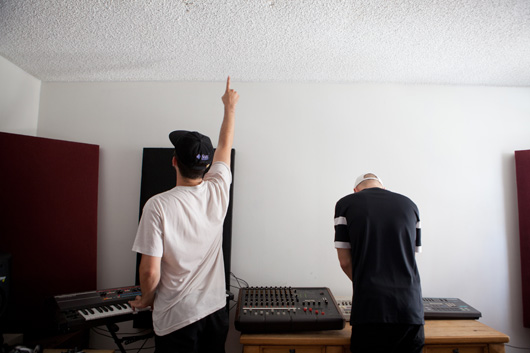In the Studio: DJ Dodger Stadium
“Lately I’ve been singing love songs by myself” echoes the vocal loop on “Love Songs,” […]
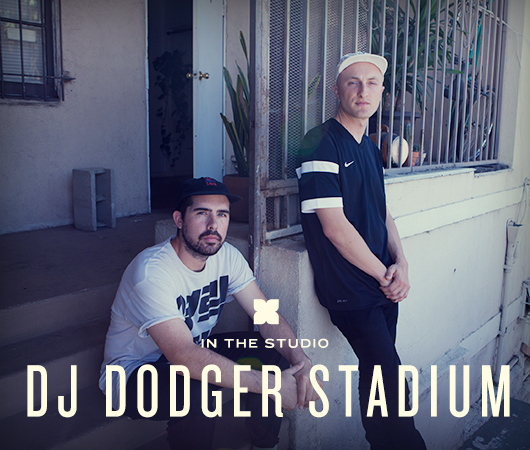
“Lately I’ve been singing love songs by myself” echoes the vocal loop on “Love Songs,” the melancholy lead single from DJ Dodger Stadium’s debut album, Friend of Mine. Fueled by heartbreak and a strong love/hate relationship with LA, the house/techno duo consisting of Jerome LOL and Samo Sound Boy (a.k.a. Jerome Potter and Sam Griesemer) has channeled these feelings into 10 carefully ordered dancefloor tracks. The two kicked off their Body High record label with a DJ Dodger Stadium EP back in 2011, but during the years that have followed, Jerome LOL and Samo Sound Boy have largely focused on polishing their label’s sound and aesthetic while maintaining prolific solo careers.
However, the return of DJ Dodger Stadium was always in the cards, and now, the duo is back with Friend of Mine, which officially drops on July 8. The record marks the first time that either Potter or Griesemer has been involved in a full-length, and it’s also the first official album in the Body High catalog. As such, Friend of Mine is effectively the label’s biggest project to date, and its creation wouldn’t have been possible without Body High’s headquarters in the middle of Los Angeles’ landmark MacArthur Park neighborhood. The two producers converted an old doctor’s office into their studio, which also features a separate room for their in-house graphic designer. This is where Friend of Mine was created, along with almost every previous Body High release from both Potter and Griesemer. Earlier this month, we were able to catch up with the men behind DJ Dodger Stadium for a walk through their studio, along with a discussion covering everything from their growing obsession with all things analog to the creative process behind their new LP.
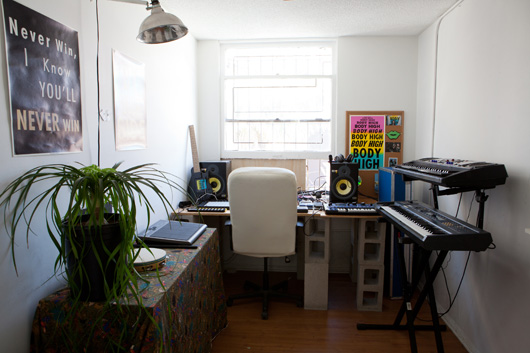
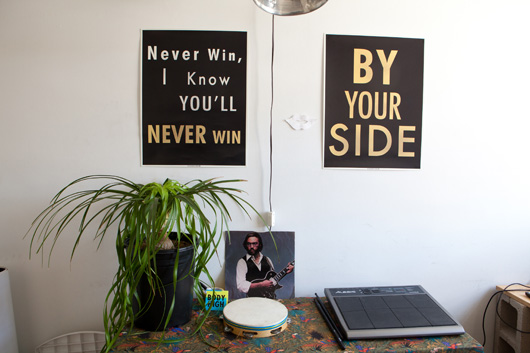
How long have you guys been using this space? Does the entire Body High crew share this space or is it mainly just the two of you?
Sam Griesemer: We’ve been using it for about two years now and yeah, the entire crew shares it. The main people who are usually here are Jerome and I, along with Max [Martin], who does all our design stuff. Joaquin [Bartra], our label manager, is here a lot too. A lot of people come in and out of here too, like Floyd Campbell comes here often to work on music and when friends are in town, they’ll come by and check it out.
Is this your first studio space outside of your own homes? What were your first set-ups like when you first moved into this space?
SG: Yeah, this is the first proper studio for both Jerome and I outside of our apartments.
Jerome Potter: Once you have a space outside of your own apartment, you kind of get in the habit of buying more and more gear to make music with—you’re a lot less limited. When I first got my studio room, it was only my laptop and monitors, which felt so bare and empty. Having a space to call my own really made me try new things, build an ideal set-up and develop an identity for the studio in a sense.
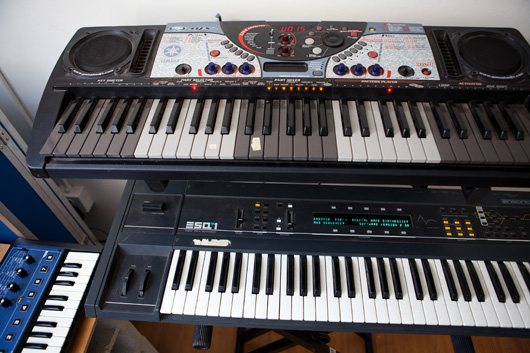
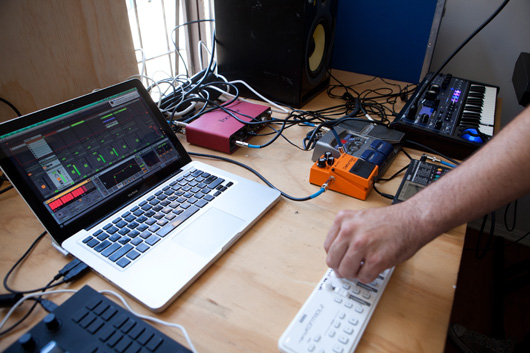
Do you guys feel that having a studio separate from your own home affects the creative process of your music?
SG: Oh yeah, so much. I think this place in particular is special because it’s walking distance from our homes. Being able to walk here is the best thing ever and it’s always really interesting to have that 15 minutes just out on the street to take in the neighborhood and see and hear what’s going on—that short period of time spent between home and the studio is very influential. This part of town is also unique and this place isn’t actually a music studio—it used to be a doctor’s office and we converted it. Next door to us is a church and a bunch of abandoned buildings; it’s pretty weird, but definitely provides a certain energy.
JP: When you’re producing from your bedroom, you could be in your boxers while also watching TV, so when you separate the studio from that environment, you treat it more like a job and you’re more deliberate with what you do. You make the most of your time spent in the studio when you don’t also live in the same place. I’m focused when I’m here and so is Sam; we get to hear what each other is working on and we’re in constant communication.
Did you guys have any criteria for an ideal space when you were initially searching for a studio, or were you open to whatever? You could totally live in this spot, it feels like a home…
SG: Location and price were the first things in mind. Although when I was handed the keys to the place from the owner, he told me, “There are two things you can’t do here. Sleep here or cook meth!” [laughs]
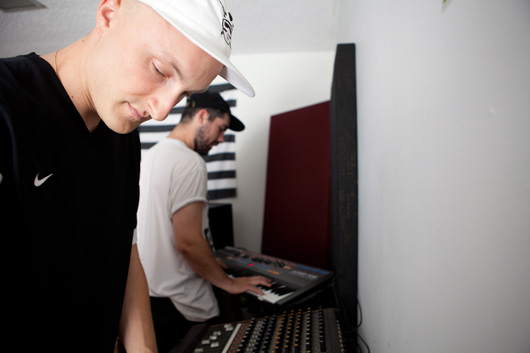
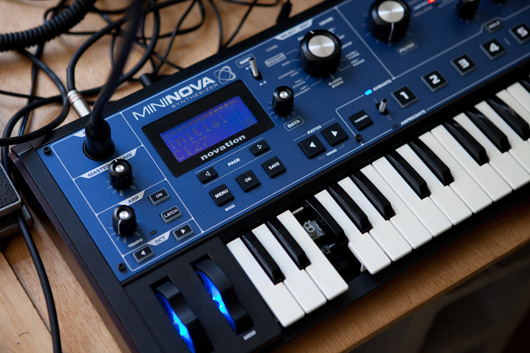
Talk a bit about the sound treatment you had to do to get this place dialed in.
SG: Well, we got these panels installed throughout the studio to improve how everything sounds. Our friend Marc [Glasser] (a.k.a. Dubbel Dutch) had a similar thing done to his place and was spending some time in LA, so he helped us build the panels and figure out where exactly they needed to be. It really helped.
What DAWs are you working with individually and together as DJ Dodger Stadium?
SG: I’m a Logic user.
JP: I’ve been using Ableton since 2007 and the new version is really great. I use the Push software a lot now, which I think is amazing. It’s changed my entire workflow. We used Push a lot together on this Dodger Stadium LP, especially for programming drums with our 909. Push was a big sequencing tool after recording on this record.
If the two of you use different software for your solo work, how do you combine when working together for DJ Dodger Stadium?
JP: For this album, we ran everything into one computer using Ableton.
SG: A lot of times, we would record stuff through Logic and then bounce the tracks into Ableton to assemble them.
JP: We used bits and pieces of both programs on almost every song. But for the most part, we were recording hardware into the programs anyway, using our synths and other analog pieces we’ve acquired over time.
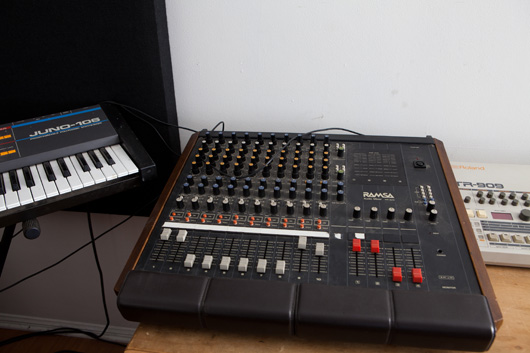
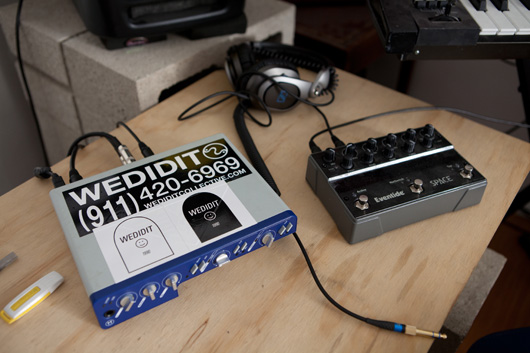
And all of your outboard gear is being run through this vintage mixer, which seems to be the centerpiece of the studio.
SG: Yeah, our friend’s dad found it at a garage sale and gave it to me, and I didn’t know what to do with it for a long time. But I think getting this mixer played a huge role in making me more interested in buying gear and figuring out more ways to make use of it. We run everything through it.
JP: It sounds amazing, you can really push stuff with it—the EQs are awesome. It gives everything some extra warmth.
SG: With just this mixer and the 909, you can really go wild and come up with some insane sounds. Everything started to make a lot more sense once this mixer enabled us to start adding more gear, it really helped make the production process much more efficient and fun. It feels more natural this way and Jerome knows I’m not that tight with computers. [laughs]
It sounds like using as much gear as possible without relying too hard on two separate DAWs made it easier to work together on the record.
JP: Exactly, we each did a lot of different things on this record too. For instance, I have this old Yamaha synth that I’ve had forever, and it’s not very good by an audio head’s standards, but I don’t really believe in that—I think you can work with anything. We made a lot of cool sounds with that.
SG: Definitely. It’s funny too because three things from this studio all came from really amazing Craigslist come ups.
JP: There was one dude in the Valley that hooked us up with the Juno, the DX7, and the ESQ.
SG: And we got the 909 from this older guy who basically had it sitting around collecting dust. He used to make weird, sci-fi-sounding beats and cut us a really crazy deal on it—super cheap. It worked out well for us. And the Casio RZ-1 is actually being lent to us by our friend Harvard Bass… it’s actually been sitting here for a while, but he can have it back whenever he wants! Our Eventide box is basically the only thing we actually bought new, which we purchased at Guitar Center. That thing is so powerful and totally crucial for our productions.
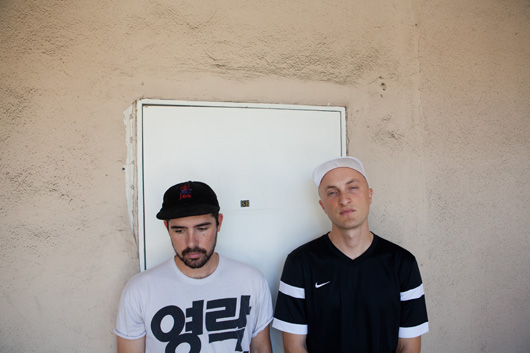
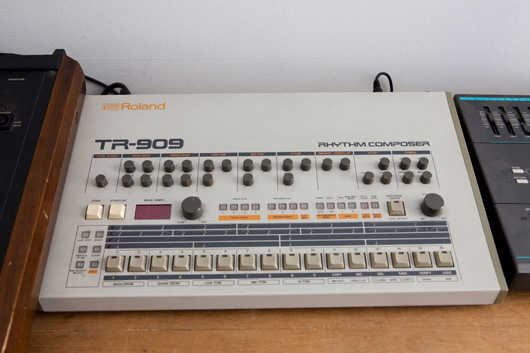
On the new record, did you play and record the synths loosely by hand, or were they hooked up through MIDI?
JP: We did both. At one point, we actually had the Juno hooked up through MIDI and used Ableton Push, and Sam was tweaking the knobs while I was playing the keys, which was a cool mix of everything. And sometimes we recorded straight-up audio from the synths too.
SG: Even with some of the more complex synth parts where we were using MIDI, we still ended up recording it back into Live and adjusted all the sounds with the gear. It was a pretty cool way to collaborate that we couldn’t have done alone.
JP: Yeah, we didn’t even know some of these methods were even possible until we sat down together and figured it out—you can’t just play the keys and then go back and tweak everything like we did live together. It was really cool.
Compared to your solo work, did any particular pieces of the studio get more attention than others on the DJ Dodger Stadium record?
SG: I’d say so. The 909 definitely got the most use though; it’s the backbone of almost every song on the record.
JP: Apart from weird loops and drum sounds from the Yamaha, the 909 handled the main drums on every song. When you work alone, you spend a lot of time deciding if something’s right, but together, the process was very quick and natural in regards to picking out sounds. It seemed best to keep it simple.
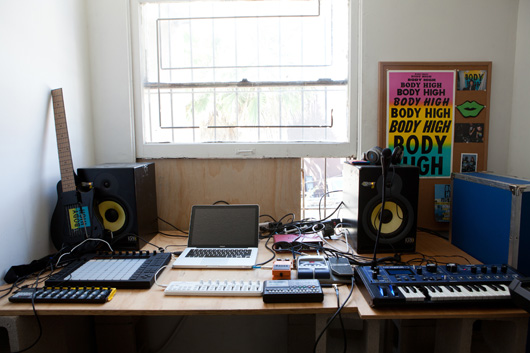
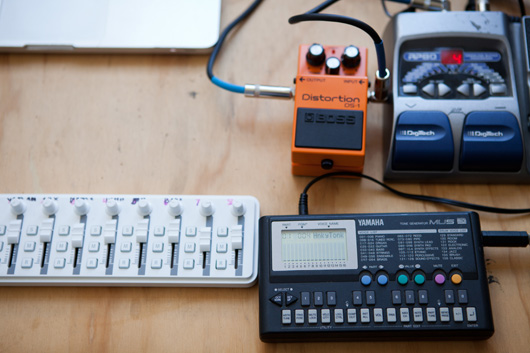
Were you guys together for the entire duration of writing and recording?
JP: Yeah, there weren’t any moments where we’d take tracks home to work on them alone. We literally did everything next to each other at the same time. It was all done entirely in this studio.
You never had sketches from home that you’d bring to the studio to work on together?
JP: Not produced sketches, just ideas we thought of that we’d discuss in the studio before making music. Of course we would think about the album on our own time, but we never actually made anything alone.
Would you say that the album tracks were conceptualized prior to writing and recording, or are a lot of these a result of spontaneous jamming and random ideas?
JP: Once we figured out the sound and vibe of the album, we kind of knew which direction to take this.
SG: We did “Love Songs” first, and I think that set the tone and feel for the rest of the record. It came naturally as a surprise, but once we had that track done, it became clear what we wanted out of this album. Another thing that’s kind of interesting is that there are 10 tracks on the album and we made 11, so there was only one song that we didn’t feel was a right fit. There wasn’t any second-guessing and we didn’t make like 60 demos or anything—we knew what we wanted, but that’s not to say it was easy or super quick. It was directed for sure.
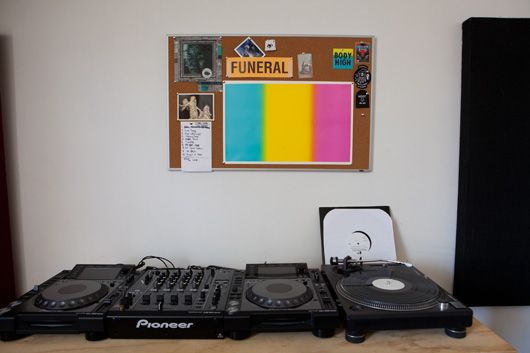
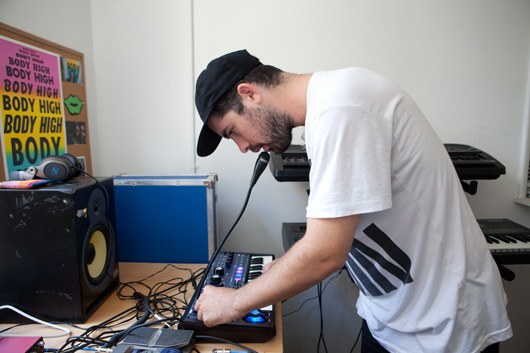
You guys were going for a cohesive record that flows like an album, rather than a compilation of random tracks.
JP: Right. It’s definitely a story and what I like most about the album is that we’ve created our own space. It’s a thing of its own and has a specific soundtrack to the whole vibe we envisioned. I’m happy we accomplished that.
SG: We knew after our first EP that we wanted to do an album next, but we needed our own label to do it, since we wanted it to be entirely our own world. This record couldn’t fit anywhere else, so we spent the last three years building our aesthetic and the team of people we work with. We couldn’t have done this album without laying the groundwork for the label and the studio. We felt clear and focused after knowing this record would be for Body High.
JP: We weren’t making an album for anyone else but ourselves.
Timing was everything in this case.
JP: Yeah, we had to wait for the right time, not only for the label, but also for our own careers and personal lives too. People probably thought the first DJ Dodger Stadium EP was a one-off thing, but we knew it was going to be something. It just wasn’t like “in 2014 we’re making an album” was a plan we set. I think the beauty of the whole project is how nothing felt forced or overly articulated.
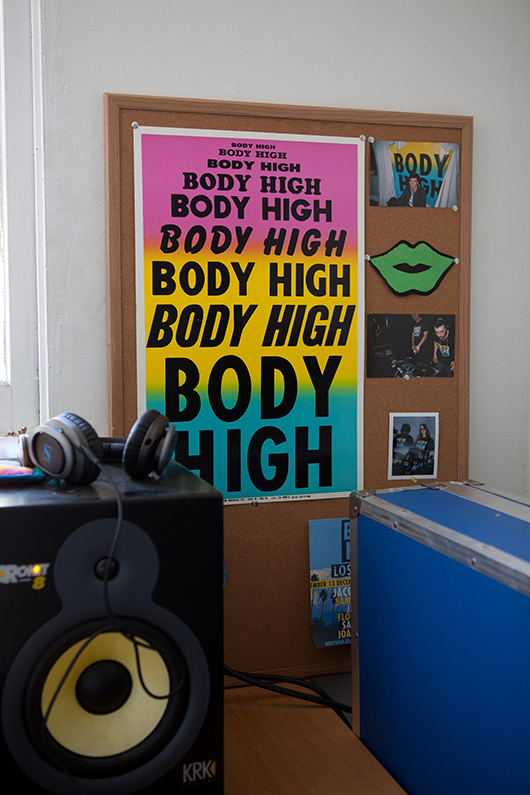
Did you guys make one track at a time, or were there several in the works simultaneously?
JP: There were a lot in the works at the same time. It started with “Love Songs,” and then we wrote three more sequentially based on that first track. We started a bunch of tracks after that and didn’t finish them until later because we had all this energy and knew we had to keep moving forward.
You guys have been working together for years at this point. Would you say that you each have set roles in the studio?
JP: Both of us always know what we want our sound to be without even talking about it. It’s not really a matter of defined roles; it’s more about open discussion and evaluating what each of us wants on a record. That’s why one song didn’t make the album, because we felt there wasn’t a point in pushing something that wasn’t working right away. We were also working on our solo stuff during the time of creating the DJ Dodger Stadium album, so we also had that release to do other things.
SG: I think once a dynamic or flow is established between two people in the studio, everything kind of happens on its own and you don’t need to make any rules or stick to certain roles. When things get moving and you’re feeding off each other’s energy, it makes you more confident.
JP: Creating an entire album, especially one with an ambitious plot like ours, is a tough thing to undertake alone. I would be second-guessing myself so much if we didn’t do it together.
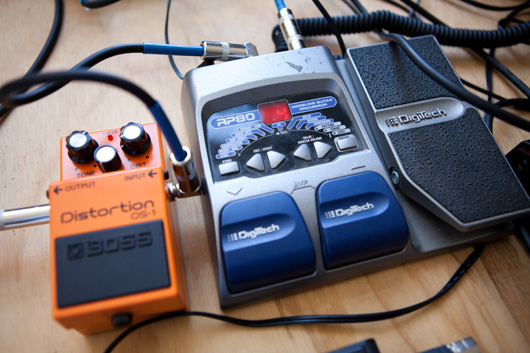
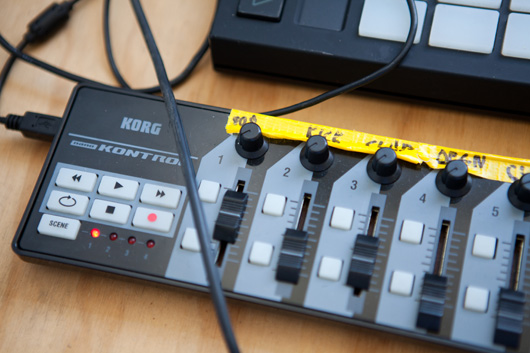
Since you guys are using a lot of hardware, would you say that the unpredictability of the gear led to some surprises that made it onto the album?
SG: Definitely! There are a lot of subtleties, tons of little textures and synth lines that came from jamming and figuring out various pieces of gear. The inclusion of gear gave everything that loose, natural feel that we wanted, and we’d often be surprised by the results in a positive way. And it would be hard to get the same results in a studio where we’d have to pay $400 per hour because we’d be against the clock trying to force it out.
Did a few jam sessions during the learning curve inspire new song ideas?
SG: I think that’s just the beauty of using gear. So many things just happen when you don’t really know what you’re doing yet, and so many cool things come from mistakes that I guess aren’t really always mistakes. You just turn it on, start recording, and let it go.
JP: Yeah, and then find the best parts later. Learning on the fly is the way to go.
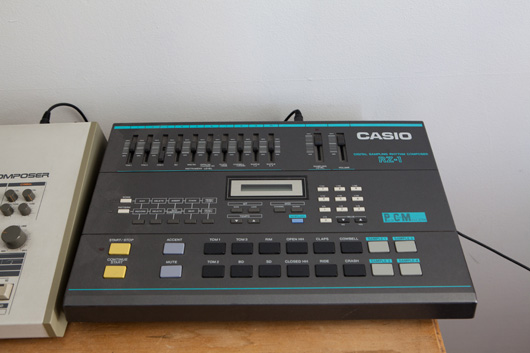
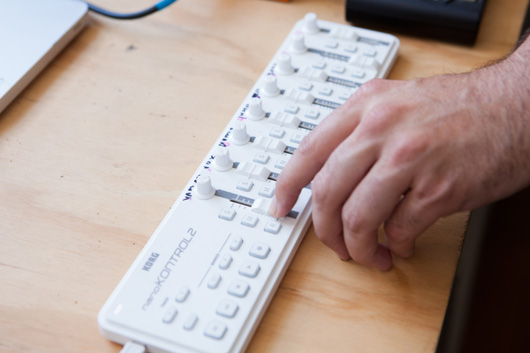
Did any tracks in particular off the album come up as a jam session surprise?
SG: Well, like we said, we did 10 tracks but there was one we weren’t pleased with, but we still wanted a total of 10. So we did one more track in the end, which is called “By Your Side.” When we were starting that one, we felt exhausted from writing…
JP: We were already doing the mixdowns of other tracks at that point, getting excited to have everything wrapped up and moving on to the mastering phase.
SG: We thought finishing the last song would be like pulling teeth because of these factors. But we ended up jamming over it and got into the groove again, and it ended up being one of our favorite tracks. That track was a real challenge, but we turned on the Juno and stumbled upon the right sounds that made us feel like it was complete. Jerome ended up writing a synth line on the second half of “By Your Side,” which is my favorite part of the track.
JP: It was literally the last thing we wrote for the album, and in terms of songwriting, I feel that it’s the standout piece.
So after “By Your Side” was wrapped up, you knew the album was complete. Did you guys do the mixing and mastering yourselves after that?
SG: We mixed everything ourselves. We did the initial mixes here at the studio, but then we took the files to other people’s spots to hear it on other systems. We did two or three days at a friend’s studio in West LA.
JP: But we still wanted to maintain a particular sound throughout all the tracks, so that was kept in mind during the mixing process. It’s more of a mental thing though, because it’s really healthy to get out of the space where you wrote and recorded everything and hear it all somewhere else. Sometimes it’s great to mix somewhere you’re not totally familiar with.
SG: Always go to as many places as possible to test your music during the mixing phase. Go to a friend’s studio and listen in your car too. Even if we had a half-million-dollar studio, we’d still be doing it like this.
JP: I wouldn’t even want a million dollar studio, I like this one! [laughs]
SG: In the end, we came back here with notes and finished the mixes in our spot. After that, we sent out our mixes to Precise in London for mastering.
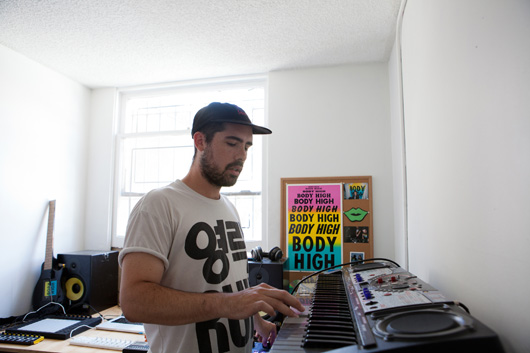
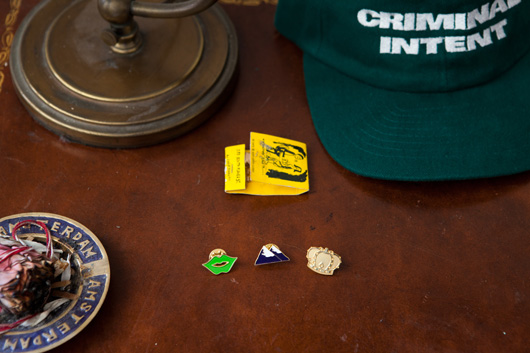
Did you guys have any go-to plug-ins for polishing the mixes off prior to mastering?
JP: We tend to keep it pretty bare. We don’t really touch the master chain, and do all of our EQing as we go. We’re constantly listening back as we go, so we don’t save that stuff ’till the very end. Obviously there are things to tweak at the end, but there’s not a one-stop solution for it.
SG: We’re really happy with the mastering job Precise did. They brought out a lot of beautiful sounds in the tracks.
JP: Precise understands what we’re going for and what we want. They are familiar with the Body High sound, but we definitely gave them specific notes for DJ Dodger Stadium and they got it.
If you could add literally anything to the studio to improve the workflow or just simply own for fun, what would you get?
SG: Well, if money wasn’t a thing, then I would get an ARP 2600 semi-modular synth. That’s like my dream piece. I also want to start my own modular kit, but I think that might ruin my life. [laughs]
JP: Marble floors and maybe an infinity pool! Nah, I’m pretty happy with what we have. We’re really lucky. It’s fun to work with what you have and just figure things out. The best advice I can give is to just work with what you got. It doesn’t matter if it’s a hundred-dollar keyboard, if you have it, just use it. We’re using Rokit 8s in here for monitors and they’re great and didn’t cost $10,000.
Are you guys are going to be playing live sets as DJ Dodger Stadium soon?
SG: We have two shows in July, with more dates to follow after.
Will that be your studio experience brought to the club, or something a little different?
SG: It’ll be a little different…
JP: We’re going to keep this one a surprise. But it will be gear-based. No screens or computers. It’ll be a fun and different way of hearing the record.
